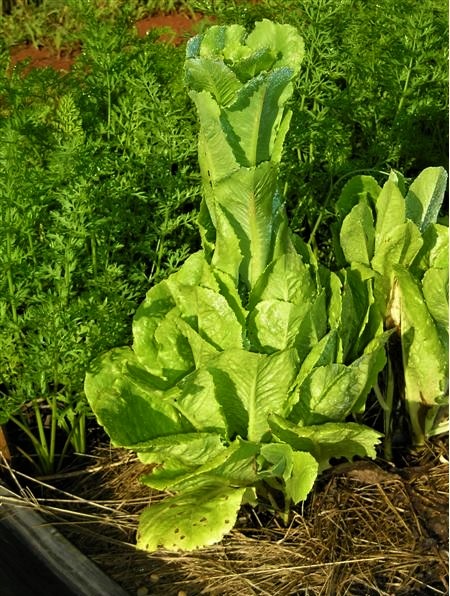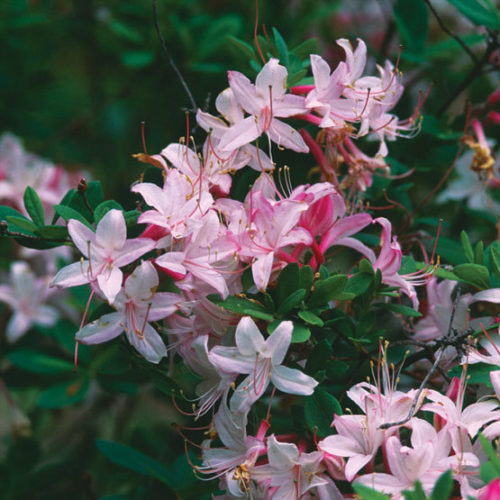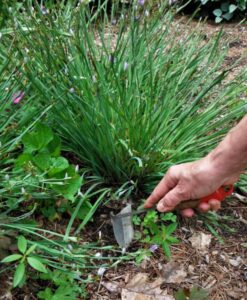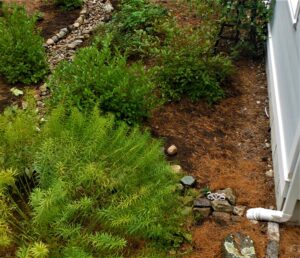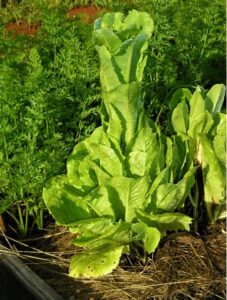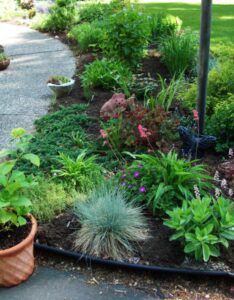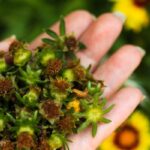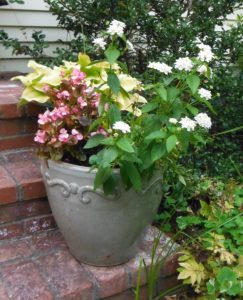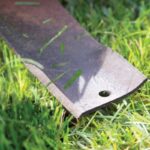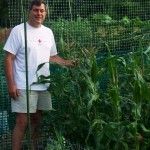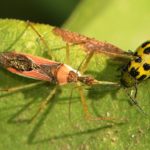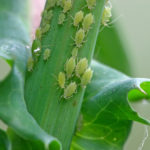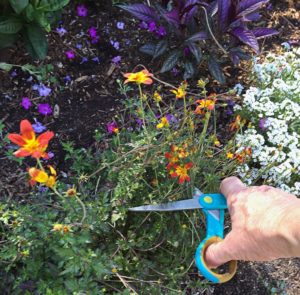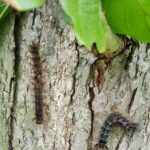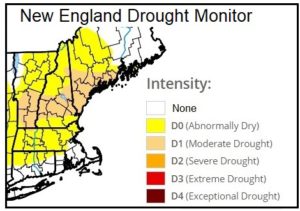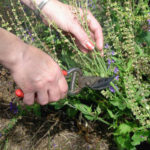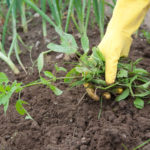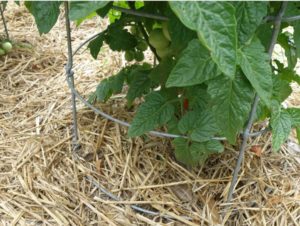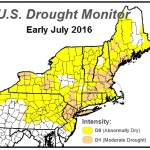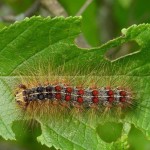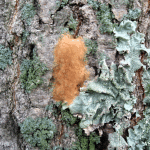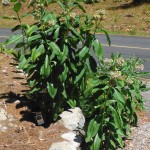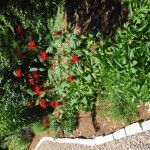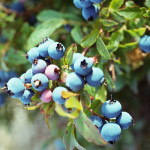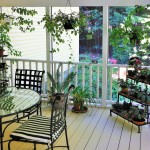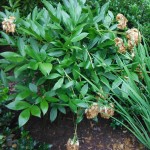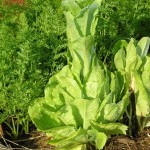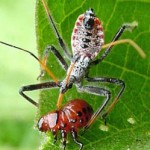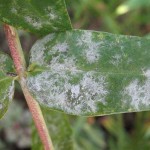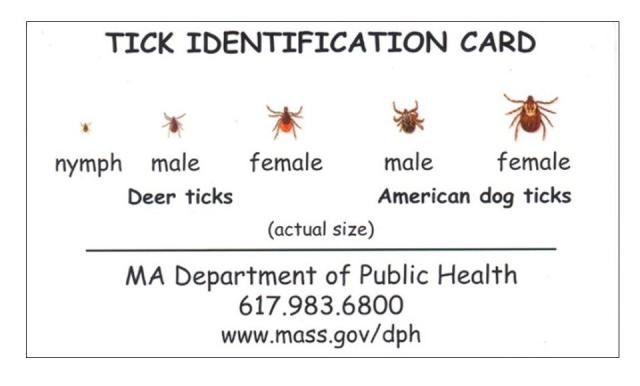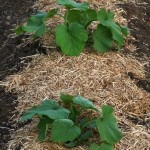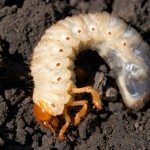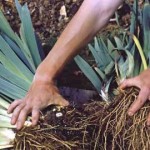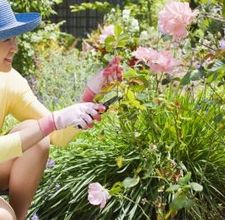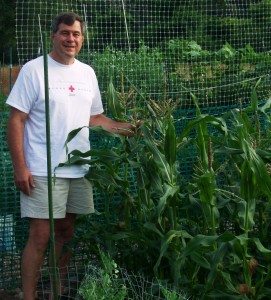Horticultural Hints – July
Put your trowel down. The heat of mid-summer is not the time to be planting vegetables. You may have a strong temptation to fill in spots in your vegetable garden where cool-weather crops have bolted or been harvested. Resist that temptation until a long-range forecast (two weeks or longer) shows the heat has broken.
Weed as though your plants’ lives depend on it. They do – your plants will be competing with weeds for water, sunlight and nutrients in July, and the weeds are, too often, better at grabbing available resources. Your flowers and vegetables win the fight only when the weeds lie, gasping for breath, in the aisles or in a bucket.
 Leave the lawn alone. Your grass wants to go dormant in the heat of summer; don’t fight Mother Nature. Trying to keep it lush and green by excessive watering or fertilizing serves only to create a cycle of chemical (and water) dependency that is both expensive and, ultimately, not all that successful.
Leave the lawn alone. Your grass wants to go dormant in the heat of summer; don’t fight Mother Nature. Trying to keep it lush and green by excessive watering or fertilizing serves only to create a cycle of chemical (and water) dependency that is both expensive and, ultimately, not all that successful.
Leave the lawn long. If you haven’t already, move the blade on your mower up to 3”. The higher grass will shade its own roots, making them less water thirsty while also shading out new weeds. Consider replacing the grass in hard-to-grow areas (shady areas for one) with perennials or shrubs that are happier in shade and require less maintenance while providing flowers and interest throughout the year.
Remove spent flowers. While there are a few varieties out there that promise endless flowers without the trouble of deadheading, most plants require you to dead-head them for a for a reliably long bloom period. Picking off flowers that have passed their peak prevents seed heads from forming and stops the plant from 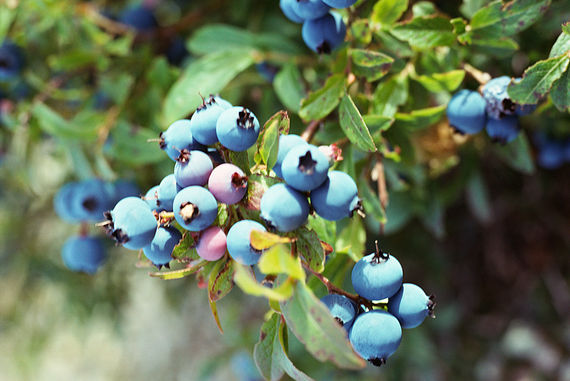 receiving a signal that its work is over. Snap off large flowers with your fingernail. For small blossoms, or hanging plants gone straggly, shear them back by half. Wait a week, and cut off anything not producing flower buds. You’ll be rewarded with a new crop of flowers and tidier plants, especially if you follow up with a light feeding.
receiving a signal that its work is over. Snap off large flowers with your fingernail. For small blossoms, or hanging plants gone straggly, shear them back by half. Wait a week, and cut off anything not producing flower buds. You’ll be rewarded with a new crop of flowers and tidier plants, especially if you follow up with a light feeding.
Be patient, whether it is blueberries turning blue or tomatoes turning red. The first sign of color is just that. Real flavor will develop over the next few days so as the berry and tomato increase in size and sugar content. With tomatoes, do not remove healthy foliage. Fewer leaves mean less food produced for the plant—and for you.
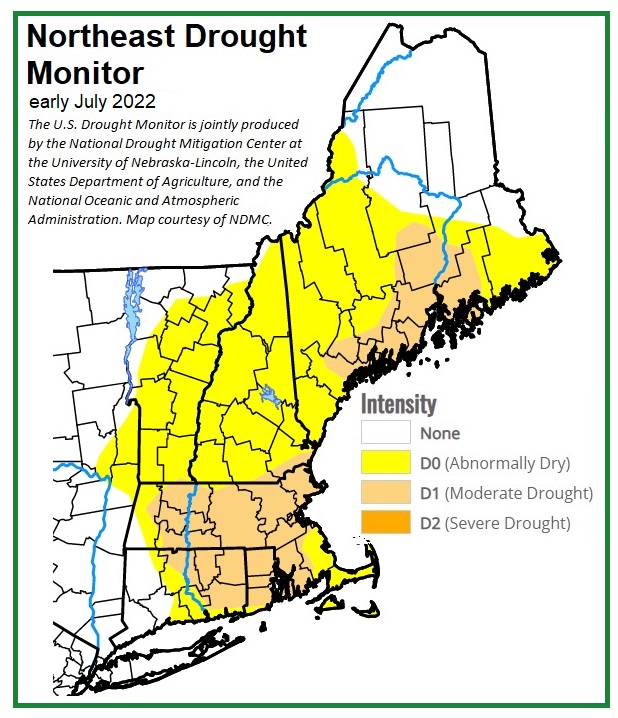 A summer drought is taking hold. The latest Drought Monitor shows almost all of New England to be abnormally dry, and parts of Massachusetts, Connecticut, Maine and Rhode Island to be in a moderate drought. What should you do? Water only what requires supplemental moisture: vegetables, annuals, and newly planted perennials and shrubs. Your lawn is a hardy perennial that wants to go dormant in summer heat. Let it go brown; it will be back in the cooler autumn, undamaged. Similarly, established trees and shrubs have root systems that tap underground moisture reserves.
A summer drought is taking hold. The latest Drought Monitor shows almost all of New England to be abnormally dry, and parts of Massachusetts, Connecticut, Maine and Rhode Island to be in a moderate drought. What should you do? Water only what requires supplemental moisture: vegetables, annuals, and newly planted perennials and shrubs. Your lawn is a hardy perennial that wants to go dormant in summer heat. Let it go brown; it will be back in the cooler autumn, undamaged. Similarly, established trees and shrubs have root systems that tap underground moisture reserves.
Think beyond the usual suspects. While there are lots of blooms in the garden in July, you may not include a number of flowering woody natives. Swamp azaleas (Rhododendron viscosum) blooms in early July when other rhodies are past flowering. Oxydendron (Sourwood tree) surprises in mid-July with white flower panicles that stay on into winter. And, in late July, summersweet (clethra) blankets itself in fragrant flowers loved by the bees and butterflies. All of these plants also tolerate at least some shade, making them adaptable and valuable additions to New England gardens. And once established (a couple of years in the ground) they can, under most conditions, dependably take care of themselves.
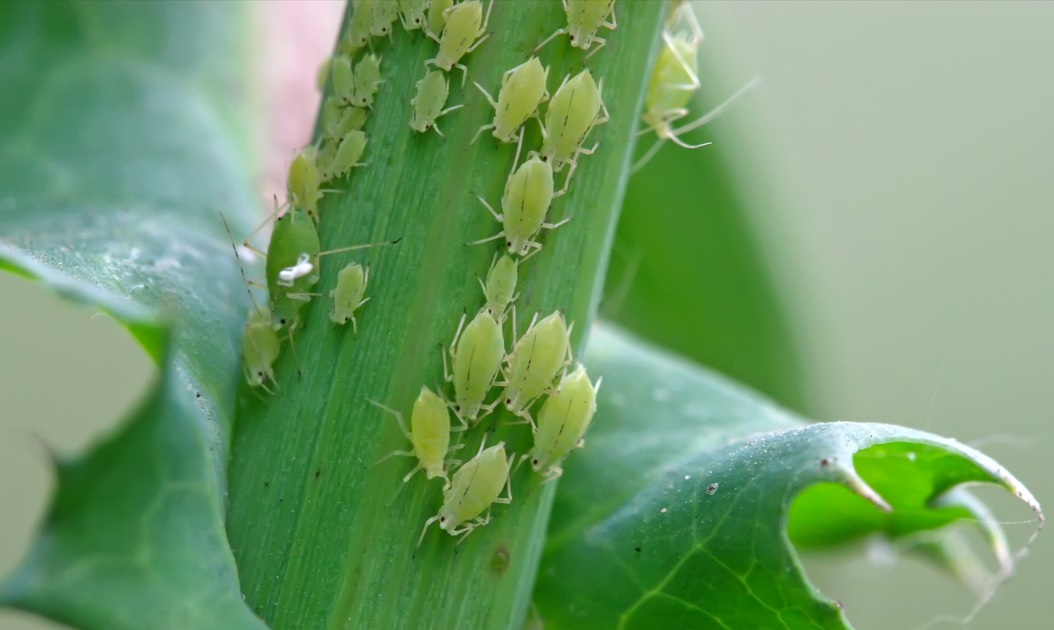 Aphid control. A strong spray from a hose will knock aphids and other insects to the ground where they often become someone else’s dinner. Spraying with pesticides should always be the last resort – and done with great caution because they will kill many beneficial insects and are harmful to other animals (including humans). Remember that over 90% of all insects are beneficial or benign so don’t pull out the toxic spray at the first sight of bugs. Are they doing any damage or are they just scary to look at? Can you live with the amount of damage they are doing — a few holes in leaves? Have you tried that jet of water or a nontoxic spray? Learning to live with the other creatures in the garden that are doing little or no harm is an important step for everyone.
Aphid control. A strong spray from a hose will knock aphids and other insects to the ground where they often become someone else’s dinner. Spraying with pesticides should always be the last resort – and done with great caution because they will kill many beneficial insects and are harmful to other animals (including humans). Remember that over 90% of all insects are beneficial or benign so don’t pull out the toxic spray at the first sight of bugs. Are they doing any damage or are they just scary to look at? Can you live with the amount of damage they are doing — a few holes in leaves? Have you tried that jet of water or a nontoxic spray? Learning to live with the other creatures in the garden that are doing little or no harm is an important step for everyone.
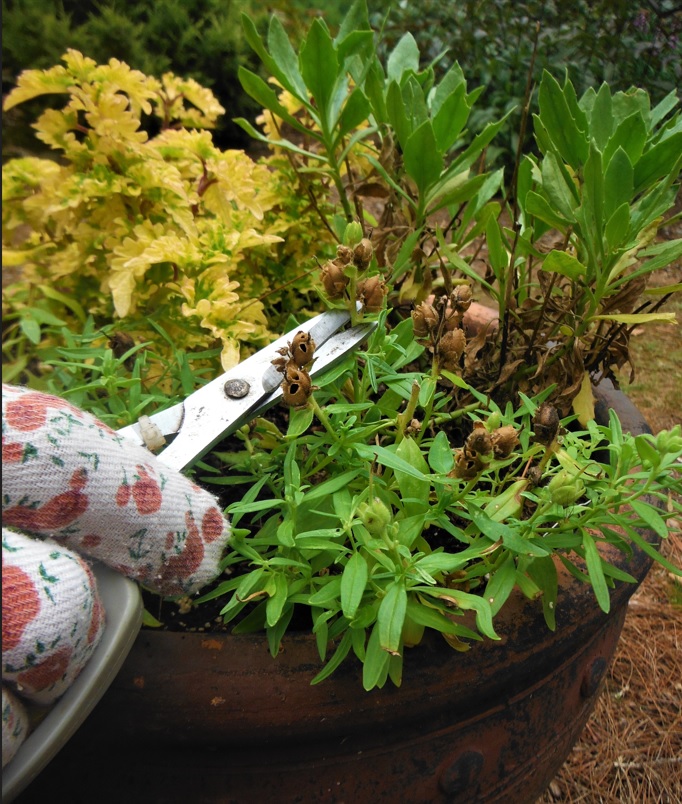 Deadhead now, see the benefits in August. Deadheading and pruning spent flowers can seem like make-work, until you realize that it will lead to more flowers, as well as a more attractive garden. Remove fading flowers from annuals, perennials and bulbs, putting them into your compost pile provided there is no sign of disease.
Deadhead now, see the benefits in August. Deadheading and pruning spent flowers can seem like make-work, until you realize that it will lead to more flowers, as well as a more attractive garden. Remove fading flowers from annuals, perennials and bulbs, putting them into your compost pile provided there is no sign of disease.
Cut back those annuals. If they aren’t allowed to go to seed, many summer-flowering plants will rebloom. Annuals particularly benefit from being cut back before producing seeds; the shorter, more compact plants may continue flowering until cold fall weather arrives.
In the vegetable garden. Squash vine borers are coming! A treatment that will not poison anything is a product called ‘Surround’. Sprayed on stems, it forms a clay coating the borers cannot penetrate, while allowing the plant to thrive.
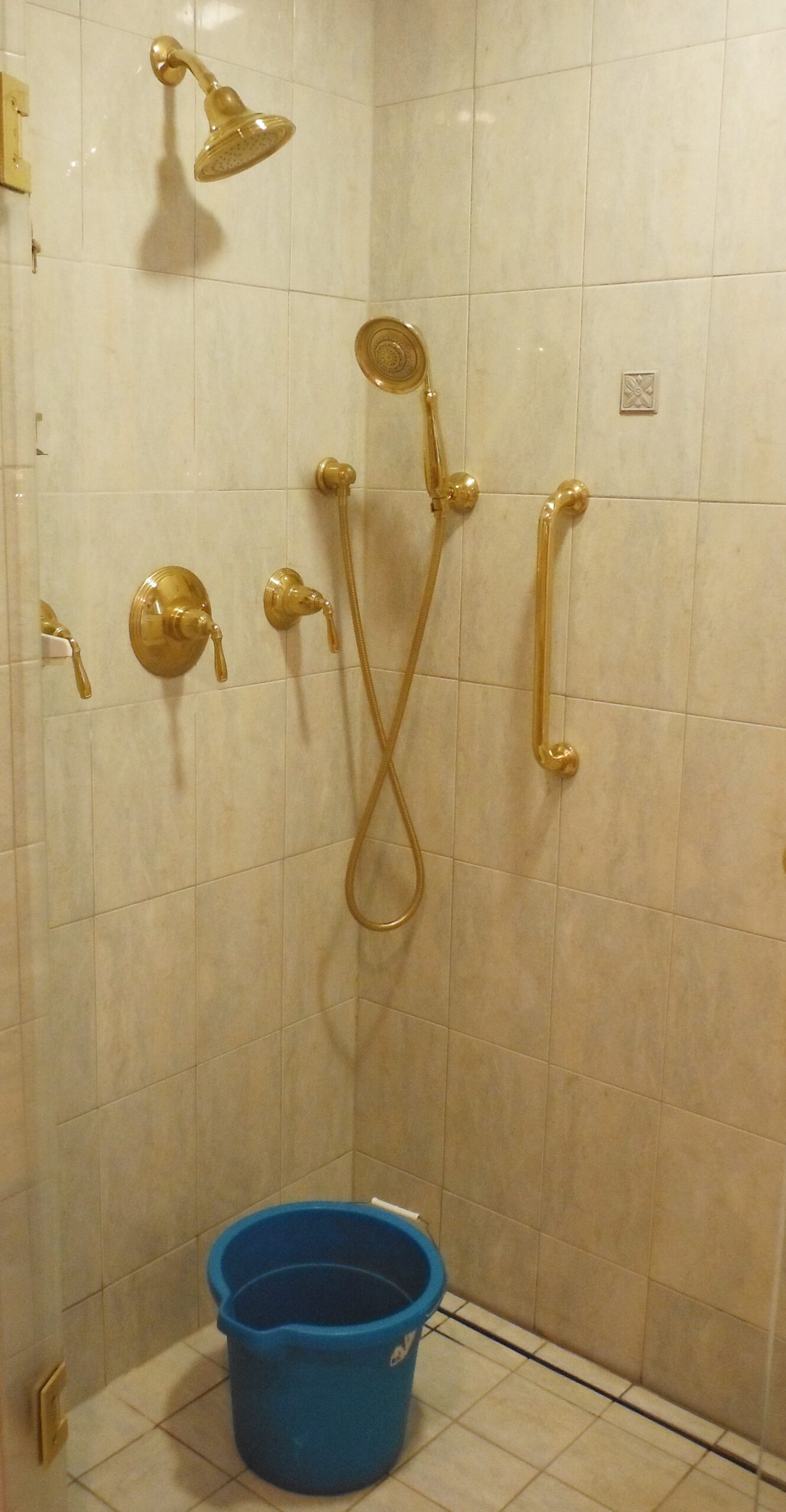 Save household water whenever you can. For example, station a bucket next to your shower and collect the cold water that initially comes out of the shower head. That trick alone can produce up to two gallons of water. Similarly, you’ll save electricity if you run water (again, into a bucket) to get it hot before starting your dishwasher. Use those buckets of water on vulnerable outdoor plants. Finally consider adding rain barrels around your home. The water off your roof can fill a 50-gallon barrel with as little as a quarter inch of rain if your downspouts direct the water to them.
Save household water whenever you can. For example, station a bucket next to your shower and collect the cold water that initially comes out of the shower head. That trick alone can produce up to two gallons of water. Similarly, you’ll save electricity if you run water (again, into a bucket) to get it hot before starting your dishwasher. Use those buckets of water on vulnerable outdoor plants. Finally consider adding rain barrels around your home. The water off your roof can fill a 50-gallon barrel with as little as a quarter inch of rain if your downspouts direct the water to them.
Time to pinch. If you missed your Fathers Day pruning of plants such as chrysanthemum and asters, start with an early July pinching. This leads to later flowers, but bushier plants with more blooms and a tidier habit. Consider cutting back balloon flower (Plactycodon) and bee balm (Monarda), dianthus, coneflower (Echinacea), Helenium, and veronica. By pinching or trimming back one or two leaf sets of the plants at the front. You’ll get an early bloom from the untouched stems at the rear and a later, bushier bloom from the remainder. It keeps your garden going stronger and longer.
Weed like your plants’ lives depend on it. They do – your plants will be competing with weeds for water, sunlight and nutrients in July, and the weeds are, too often, better at grabbing available resources. Your flowers and vegetables win the fight only when the weeds lie, gasping for breath, in the aisles or in a bucket.
It’s not too late for vegetables. We still have more than 60 days of growing season remaining, and the soil is at its warmest this month. From seed, you can plant beans, corn, lettuce, spinach, and beets, and have an excellent harvest from mid-August to (absent an early frost) October. If you can find tomato and pepper plants that are not ‘leggy’ (tall and spindly), you can also still enjoy those vegetables this summer.
Water deeply. July got off to an extraordinarily wet start but, on average, July is New England’s driest month. When you water, really soak your plants – just your plants and not the garden as a whole. You want the roots to have water available down where the heat of the day doesn’t penetrate. Watering down to that depth will encourage your plants to stretch down their roots. It really happens like that: plants can ‘learn’ to grow a certain way through training, and getting water down deep works remarkably well.
Water early and low. When you water mid-day, you’ll allowing the water to evaporate rather than getting to your plants. Watering low (meaning right down at ground level) ensures the water doesn’t have much chance to evaporate. If you can’t water early, water late – when the sun is setting. To prevent spreading plant diseases, keep the water off the leaves as much as possible.
Remove the spring (cool weather) plants that can’t take July’s heat. They’ll neither look nor taste good after the 90+ degree days anyway. In the vegetable garden, that means things like spinach and lettuce; elsewhere, it also means those early pansies, nasturtiums, and their short-lived brethren.
Help stop evaporation. Heat-treated straw, seaweed from the beach (first washed in fresh water), and other mulches that will allow the water to pass through and prevent the sun from evaporating the water out of the top inches of the soil. Saving water at the root level is very important when the soil has heated up—like after a few days of 90+ temperatures.
Leave the lawn alone. Your grass wants to go dormant in the heat of summer; don’t fight Mother Nature. Trying to keep it lush and green by excessive watering or fertilizing serves only to create a cycle of chemical (and water) dependency that is both expensive and, ultimately, not all that successful.
Compost tip. Growing plants consume the nutrients in the soil, so replace them naturally by using good compost as a mulch. You’ll get two jobs done (mulching and fertilizing) in one. And, unlike chemical fertilizers, compost will improve the soil health at the same time.
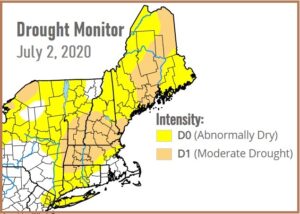 Drought watch. New England received desperately needed rain at the end of June. That’s the good news. The bad news is that we’re still significantly below average for the year. Also, with that rain, you will need to spend some time removing the weeds that took advantage of the additional moisture to pop up in flower and vegetable gardens and perhaps in your lawn. Weed killers are a particularly bad choice when ‘good’ plants are also battling heat and drought. Use cool mornings or overcast days to hand-weed flower, shrub and vegetable beds.
Drought watch. New England received desperately needed rain at the end of June. That’s the good news. The bad news is that we’re still significantly below average for the year. Also, with that rain, you will need to spend some time removing the weeds that took advantage of the additional moisture to pop up in flower and vegetable gardens and perhaps in your lawn. Weed killers are a particularly bad choice when ‘good’ plants are also battling heat and drought. Use cool mornings or overcast days to hand-weed flower, shrub and vegetable beds.
Remove spent flowers. While there are a few varieties out there that promise endless flowers without the trouble of deadheading, most plants require you to dead-head them for a for a reliably long bloom period. Picking off flowers that have passed their peak stops seed heads from forming and prevents the plant from receiving a signal that its work is over. Snap off large flowers with your fingernails. For small blossoms, or hanging plants gone straggly, shear them back by half with scissors. Wait a week, and cut off the remainder. You’ll be rewarded with a new crop of flowers and tidier plants, especially if you follow up with a light feeding.
 Bugs! It’s hot and humid and the insect hordes will soon be upon us. Simple solutions often keep their numbers down to manageable levels without resorting to chemicals. A strong spray from a hose (in the morning please) will wash off aphids and many others, killing some and leaving others exposed to their enemies.
Bugs! It’s hot and humid and the insect hordes will soon be upon us. Simple solutions often keep their numbers down to manageable levels without resorting to chemicals. A strong spray from a hose (in the morning please) will wash off aphids and many others, killing some and leaving others exposed to their enemies.

A safe deterrent to fungus and mildew is a spray consisting of a tablespoon of baking soda in a gallon of water
Diseases! Bad bugs are enough of a problem, but what about when everything looks great one day and the next you have fungal disease such as mold or mildew? Start with what you can control. Always water early in the day so the leaves dry quickly. Keep a clean garden, removing plant debris, especially if there is any chance it is infected. An organic preventative is a solution of one tablespoon of baking soda in a gallon of water sprayed on the leaves. This makes it difficult for fungal spores or mildew to become established on ornamental plants or food crops. And, water at the roots, not from above.
Annuals, particularly those in containers, need additional fertilizer throughout the summer. If you are using a slow-release fertilizer (as many potting mixes do), check the container to see how long it should last – usually three to six months. If you planted in early May with a three-month fertilizer, you will need to add more by late July. Some gardeners prefer to apply a diluted liquid fertilizer to containers in order to ensure that the heavy feeders get all they need without overdosing the plants that like a leaner diet.
Shear joy. If your annual blooms are slowing down, or the plants are getting overgrown or scraggly, give them a hard shearing to encourage new growth and new flowers. A shearing just before you leave on vacation should mean you come home to lush new growth – if you have a faithful waterer tending the pots.
Lawns. If you haven’t already, move the blade on your mower up to 3”. The higher grass will shade its own roots, making them less water hungry while also shading out new weeds. Consider replacing the grass in hard-to-grow areas (shade for one) with perennials or shrubs that are happier in shade and require less maintenance while providing flowers and interest throughout the year.
Vegetable Gardens. It’s too early for tomatoes yet, but you should be harvesting green beans, lettuce, peas, beets, chard and onions among others. Plant a new row of lettuce, carrots, beets and chard to extend the season for those. Replant zucchini and green beans when the first batch blooms, keeping the new plants under floating row covers to exclude squash borers and bean beetles. Though row cover looks opaque, they allow over 90% of the sunlight and water into the plants.
Spinosad, a biological control, can be sprayed on plants up to eight days before harvest. Once it dries it affects only those insects that weaken plants by chewing on leaves. It has no effect on pollinators like bees and butterflies.
If you are growing corn, it may need a supplemental feeding before the end of the month. Carefully scratch in a small amount of fertilizer around the roots, then water thoroughly if rain is not expected.
What a difference a year makes. Don’t take my word for it: scroll down to the Drought Monitor chart for July 2018. We have had a very wet spring and summer – meaning the need for irrigation has been nearly non-existent. If you have an automatic system, save water, water bills and your plants by adding a rain gauge that overrides any automatic watering. Grass, perennials, shrubs and trees are all happier when they don’t get water when it’s not needed.

Clethra – summersweet or sweet pepperbush – will start its long bloom this month. It’s a native and a pollinator magnet that belongs in any garden.
Think beyond the usual suspects. We have lots of blooms in the garden in July, but some you may not think of first include a number of woody natives. Swamp azaleas (Rhododendron viscosum) blooms in early July when other rhodies are passed. Oxydendron (Sourwood tree) surprises in mid-July with white flower panicles that stay on into winter. And, in late July, summersweet (clethra) blankets itself in fragrant flowers loved by the bees and butterflies. All of these plants also tolerate at least some shade, making them adaptable and valuable additions to New England garden.
Evergreen care. If you do your hedge trimming on evergreens now, you are catching them at the end of a growth period, so the results will last until next spring. More importantly, any growth that does occur will have time to harden off before the cold weather arrives.
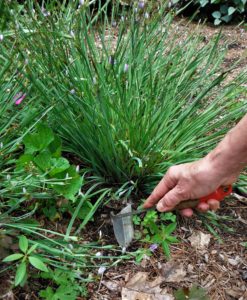
This blue-eyed grass’s nutrients are being sapped by weeds like oxalis and violets. Use a hand tool to slice weeds at the roots so as not to disturb the plant.
Perennial time. July is a month when many perennial flowers take center stage. Weeding is vital to keep the plants the main attraction. Use hand tools to slice weed roots so you don’t disturb the roots of the plants you want. Water regularly if Mother Nature doesn’t.
Compost tip. Growing plants consume the nutrients in the soil, so replace them naturally with good compost as a mulch. You’ll get two jobs done (mulching and fertilizing) in one. And, unlike chemical fertilizers, they improve the soil health at the same time.
What’s that insect? Watch for signs of pest infestations or the advent of disease. Don’t panic when you see an insect on a favorite plant – it may be a pollinator, or resting and never cause a problem. Or there may be a predator insect a branch a way who will eat it and its kind. Or, the one you see may be beneficial, eating aphids and other bugs or pollinating your plants.
Aphid control. A strong spray from a hose will knock aphids and other insects to the ground where they often become someone else’s dinner. Spraying with pesticides should always be the last resort – and done with great caution because they will kill many beneficial insects and are harmful to other animals (including humans).
Deadhead now, see the benefits in August. Deadheading and pruning spent flowers can seem like make-work, until you realize that it will lead to more flowers, as well as a more attractive garden. Remove fading flowers from annuals, perennials and bulbs, putting them into your compost pile as long as there is no sign of disease.
Cut back those annuals. If they aren’t allowed to go to seed, many summer-flowering plants will rebloom. Annuals particularly benefit from being cut back before producing seeds; the shorter, more compact plants will often continue flowering until cold fall weather arrives.
In the vegetable garden. Squash vine borers are coming! A treatment that will not poison anything is a product called ‘Surround’. Sprayed on stems, it forms a clay coating the borers cannot penetrate, while allowing the plant to thrive.
Gypsy moth caterpillars: late-breaking news. Late June brought exceptionally hopeful news on gypsy moths. Our cool, wet spring activated Entomophaga maimaiga, a fungal pathogen fatal to gypsy moths and specific to that New England pest. Multiple research stations reported die-offs of up to 70% in the latter half of June. According to researchers, “Given that gypsy moth caterpillars were at a much lower density this year, this could be the final straw that drives them to low, non-pest densities that we hope to enjoy for at least the next few years (possibly decades if history is any indicator).”
Watering wisely. Even with two inches of rain at the end of June, much of New England is solidly in an ‘early-stage’ drought condition. As such, we all need to think twice before running for the hose. Most trees, shrubs, lawns and perennials do well during dry periods if they have been in the ground for a couple of years. Watering early (finished before 9 a.m.) or late in the day (after 6 or 7 p.m.) reduces water loss to evaporation. Remember to water only plants—not sidewalks, driveways or mulch beds, so water by hand and put away the sprinkler.
Save water indoors with all the commonsense standbys—shorter showers, collecting the water run to get hot water, collecting the water used to rinse vegetables to water outdoor plants. Use mulch to hold water in the soil, but never more than two inches—too much mulch prevents water from getting into the soil.
Perennial Upkeep. Deadheading perennials not only keeps the garden more attractive, but also can lead to repeat blooms on many plants such as salvia, geraniums and even delphiniums. While you’re at it, clean up any diseased leaves to prevent spreading the problem. Finally, trim back any perennials or annuals that are getting too vigorous and taking over their neighbor’s space.
Planning ahead, you can fight mildew before it appears on plants such as monarda and phlox. A solution of one tablespoon of baking soda in a gallon of water is a safe treatment which slows down this annual nuisance.
Keep Weeding! Weeds in any garden—vegetable, perennials, shrub and even lawns—steal food, water and sunlight, crowd less aggressive but more desirable plants and detract from the beauty of the garden. Cut them off at the base, dig out big roots and, as a last resort, spot treat them with herbicides. One great technique is a small container of appropriately diluted herbicide applied directly to the weed with a sponge brush from craft stores. Nearby (wanted) plants will feel no ill effects, which happens too often if you spray.
Annuals need additional fertilizer throughout the summer. If you are using a slow-release fertilizer, check the container to see how long it should last – usually three to six months. Liquid fertilizers allow you to ‘dose’ those that seem to need a mid-summer pick-up.
If the blooms are slowing down, or the plants are getting scraggly, give them a hard shearing to encourage new growth and new flowers. A shearing just before you leave on vacation should mean you come home to lush new growth – if you have a faithful waterer tending the pots.
Lawns. If you haven’t already, move the blade on your mower up to 3”. The higher grass will shade its own roots, making them less water hungry while shading out new weeds. Consider replacing the grass in hard-to-grow areas (for example, shade or embankments) with perennials or shrubs that are happier in shade and require less maintenance. With watering bans now a reality, remember that grass that browns out in the summer will come back green and healthy with late summer and fall rains.
Vegetable Gardens. Vegetables need regular watering to produce well. Dry spells stunt the plants and reduce the size of the crop they produce. But you can save water by keeping plants mulched, watering in the early morning or just before sunset when you won’t lose water to evaporation. Mildew can be a problem on basil, keep leaves dry by watering at the root level.
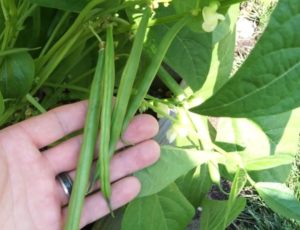
Harvest your midseason vegetables like green beans and re-plant those you’ll harvest in late August and September
It’s too early for most tomatoes yet, but you should be harvesting green beans, lettuce, peas, beets, chard and onions among others. Plant seeds of lettuce, carrots, beets and oriental greens deeper now than you did in the spring so they do not dry out too quickly on hot days. Replant zucchini and green beans when the first batch blooms, keeping the new plants under floating row covers to exclude squash borers and bean beetles. Though row cover looks opaque, they allow plenty of sunlight and water into the plants.
Spinosad, a biological control, can be sprayed on plants up to eight days before harvest. Once it dries it affects only those insects that weaken plants by chewing on leaves. Always spray very early in the morning or at dusk to get the bad guys and leave the beneficial bugs to work for you.
If you are growing corn, keep after weeds. Corn may need a supplemental feeding this month. Skip the general fertilizer and scratch in a small amount of nitrogen fertilizer around the roots, then water thoroughly if rain is not expected. Dried blood from garden centers or farm stores is an excellent biological source of organic nitrogen.
The heat is on! As the weather turns hot and water bans abound, set your priorities and use some old tricks. First, skip watering the lawn. It’s OK to allow it to turn brown. It isn’t dead or dying; it is waiting out the heat; ready to green up with cooler temperatures and rain in the fall. Your highest priority is your vegetable garden (assuming you have one). You will be eating those plants so give them first dibs. Water newly planted trees and shrubs next — they are expensive and take a long time to get settled so don’t let them suffer. Next perennials. Finally, water annuals only if you have it to spare.
Here are some tried-and-true ways to make your watering more effective. First, water early in the morning when it’s coolest and the water will soak in and not evaporate. Watering in the evening promotes diseases because wet leaves are a perfect habitat for molds, mildews and the like.
Second, always water deeply to encourage plant roots to travel down to the cooler soil that stays wet longer. Check with a trowel to see how deep the water has gone—three to four inches should be the minimum for vegetables and perennials; deeper for trees and shrubs.
Third, put plants with similar water needs together, such as hostas. Similarly, sedums and succulents need much less frequent watering, allowing you to periodically skip that part of your garden.
Finally, save household water whenever you can. For example, station a bucket next to your shower and collect the cold water that initially comes out of the shower head. That trick alone can produce up to two gallons of water. Similarly, you’ll save electricity if you run water to get it hot before starting your dishwasher. Why not run it into a bucket to use on outdoor plants? Finally consider adding rain barrels around your home. The water off your roof can fill a 50 gallon barrel with as little as a quarter inch of rain.
Pests abound. Our abnormally dry spring yielded one unwanted summer bumper crop: pests and disease. Gypsy moth caterpillars, which in the 1980’s devastated many areas, have returned this year in significant numbers. Why? Because the fungus that keeps these pests in check most years needs spring rains to proliferate and kill caterpillars before they can do damage. Dry weather has meant a banner year for the leaf destroying pests. In some parts of the state, many trees were stripped bare and are now trying to replace some of their leaves to make it through another year. If the trees in your yard are affected, water them regularly to help recovery.
It’s too late to do anything about the gypsy moths this year but, next winter and early spring, look for beige masses of eggs of trees, remove them or spray them with horticultural oil and then talk to your arborist about other treatments after the eggs hatch.
Another common sight this year are white pines with browning needles. For many trees this is not caused by cold weather or drought but, rather, by a fungus that attacks the trees in the spring when there is insufficient rain to kill the disease (sound familiar?). While some trees may be water stressed, you and I cannot tell the difference. You need to have a licensed arborist take samples and have them properly examined. If the problem is fungal disease you will need to help the tree with additional water to help it put out a second set of needles. For the future, cross your fingers that we get a wet spring next year.
The scent of summer. Last week on a walk to the mailbox, I found myself amidst the most wonderful fragrance. None of the usual suspects – Carolina sweet shrub, daphne, roses or oriental lilies – were nearby and I was at a loss until I realized it was the milkweed plants. I hate true weeds in my garden as much as anyone. But there are plants (think ironweed and butterfly weed) who don’t deserve the “weed” label, though it has stuck. Milkweed is one of them. It has lovely balls of pink flowers that attract bees and butterflies; and sturdy, pretty foliage that is the source of life for Monarch and a few other butterflies that, in their caterpillar stage, can only live on milkweed leaves. But the scent of a small patch of milkweed has made my walk to the mailbox a delight. Ignore the scoffers, plant that “weed”, invite the beautiful insects into your yard and reap all the benefits
Time to pinch. If you missed your Fathers Day pruning of plants such as chrysanthemum and asters, start with an early July pinching. This leads to later flowers, but bushier plants with more blooms and a tidier habit. I also cut back some of my balloon flower (Plactycodon) and bee balm (Monarda), dianthus, coneflower (Echinacea), Helenium, and veronica. By pinching or trimming back one or two leaf sets of the plants at the front. I get an early bloom from the untouched stems at the rear and a later, bushier bloom from the remainder. It keeps your garden going stronger and longer.
Previous July Hints
Now that we’ve had some rain…the lawn needs to be mowed. Keep it high, no less than 2 1/2 inches; three inches is even better. At that height the grass is making lots of food to send to the roots, the roots are shaded from the sun on hot days and these two conditions will lead to a dense turf and a deep root system.
And remember grass clippings act to feed the lawn as they break down. Also, grass clippings do not cause thatch. So save yourself the trouble of bagging and disposing of clipping and give the lawn a light feeding (from the clippings) every time you mow.
Be patient, whether it is blueberries turning blue or tomatoes turning red. The first sign of color is just that. Real flavor will develop over the next few days so as the berry and tomato increase in size and sugar content. With tomatoes, do not remove healthy foliage. Fewer leaves mean less food produced for the plant—and for you.
Give your house plants a summer vacation. The best summer camp for houseplants is on a screened porch where they can enjoy the extra sunlight and fresh breezes without meeting up with insects or diseases from the “real world’. It also makes bringing them back indoors for the winter less work because you need worry less about “hitchhikers”. Do remember the extra sunlight and warm breezes will require more frequent watering and regular, dilute feedings to keep them going strong.
Annuals whether they are planted in the ground or in containers can usually use a haircut about now. Trim them back up to halfway (be sure to leave some leaves to produce food) and get rid of leggy growth on geraniums, petunias, or any other that shows more greenery than flowers. Add a dose of weak fertilizer and in two weeks you’ll be rewarded with a new crop of flower buds. Frequent deadheading keeps the flowers coming. Make certain they never dry out or the flowers will stop.
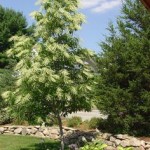
Tired of deadheading annuals and perennials? Consider summer-blooming trees like this oxydendrum that blooms in July and August
Perennials need less care than annuals once established, but to look their best, they need some maintenance. When you prune off the finished flowers, you send the plant’s energy to the roots rather than to seed production. Tired of deadheading? Consider summer blooming shrubs. We all know roses and hydrangeas, but have you ever noticed flowers on Clethra (June flowers and a great fragrance), caryopteris (blue flowers in late summer) or daphne that can bloom from spring to fall? Or have you been stopped in your tracks by the summer blooming trees including Oxydendron (sourwood tree) or Stewartia or Franklinia?
Any long-season crops in the vegetable garden may do well with a side dressing in mid-summer. Not something for the salad bowl but, rather, a light fertilization to get corn, melons, winter squash, onions and the like through the next couple of months.
It’s also time to replant beets, carrots, lettuce (with a little shade from corn or trellised cucumbers, if you can), swiss chard, and green beans. Keep your vegetables well watered by watering deeply in the morning so the water is in the ground before the heat of the day. Watering in the evening promotes disease, especially fungi, that multiply rapidly on the wet leaves on a warm night.
It’s July maintenance time in the garden. Whether you are working in the vegetable garden or a flower bed, doing that work in the morning of a hot, dry day gives you a step up. Weeds dislodged by hand or hoe will wilt quickly and die in the midday sun. When the soil is dry, you can dislodge weeds without altering the soil structure. The plants you want benefit from the reduced competition for water and sunlight. If you water your garden, try to do it early in the morning. Early-morning watering prevents loss through evaporation in the hot sun. Water left sitting on leaves overnight provides a perfect breeding ground for mildews and funguses.
Clean up spent flowers. Whether it is the brown mounds of peony flowers, the spent flower stalks of salvia or the seed heads of columbine, remove them now. Removing the peony seed pods will leave attractive ‘shrubs’ for the remainder of the season; trimming back the salvia and geraniums will bring fresh blooms in a couple of weeks; and shearing back leggy annuals such as petunias, verbena or geraniums create neater plants with new flowers. Remove faded roses to the first five-leaf cluster to encourage new blooms.
In the vegetable garden. Keep picking lettuce, chard, spinach until they bolt (leafy vegetables ‘bolt’ by sending up a flower stalk that instantly makes the leaves bitter). As spaces open up, plant short rows of lettuce, beets, carrots (such as Danvers half long that grow quickly) for harvesting into fall. (I put 3 ft. x 2 ft. squares of lettuce and such between tomato plants to take advantage of the space as well as the cooling shade provided by the tall tomatoes.) Pull and compost pea vines and plant a row of green beans in their place.
Keeping beans, squash and potatoes under floating row covers will prevent attacks by destructive insects such as Mexican bean beetles, Colorado potato beetles and squash and beetles. The covers can stay over the potatoes and beans until harvest, they do not need to be pollinated. The covers should come off the squash as soon as the second flower appears — the first flower is always male and only female flowers produce fruit — and by then, the plant is older, tougher and better able to resist insect attacks.
A few vegetables can benefit from a side dressing of nitrogen now. In particular, corn needs a boost from a nitrogen fertilizer along each row when it is knee high. Vining crops such as tomatoes and squash can use a gentler jolt of fertilizer as they begin to set fruit.
Blueberries are turning blue now, but don’t pick them as soon as you notice color. The berries get sweeter each day they stay on the plant so holding off for about four days will yield a much more delicious treat, as long as you have protected them from hungry birds and other blueberry lovers.
Insects, insects, insects! It looks like another banner year for mosquitoes and ticks. Protect yourself whenever you are outside from the dangerous diseases they carry. It’s also slug season. Use only products with iron phosphate listed under ingredients to go after slugs and snails because they are harmless to other wildlife and the environment. Look for red lily beetles and remove them by hand as soon as you see them.
Please remember that over 90% of all insects are beneficial or benign so don’t pull out the toxic spray at the first sight of bugs. Are they doing any damage or are they just scary to look at? Can you live with the amount of damage they are doing — a few holes in leaves? Have you tried a hard jet of water or a nontoxic spray? Will spraying kill bees or other pollinators who are already endangered by the many toxic products used on lawns and gardens? Learning to live with the other creatures in the garden that are doing little or no harm is an important step for all gardeners.
It was an unusual June – chilly days followed by scorching heat and torrential downpours – with probably twelve inches or more of rain recorded once the record books close. The good news is that the rain we received during the heat wave helped plants survive; and the rain we got after the heat wave ended replenished the ground water. But, heat or not, gardeners need to keep working.
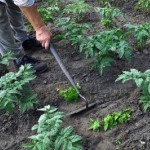 Weeds have sprung up everywhere. They need to be pulled, hoed out or otherwise removed so they do not steal the light and water from the plants you want to grow. Remember that each weed produces hundreds or thousands of weed seeds if you ignore them.
Weeds have sprung up everywhere. They need to be pulled, hoed out or otherwise removed so they do not steal the light and water from the plants you want to grow. Remember that each weed produces hundreds or thousands of weed seeds if you ignore them.
Many pests also appreciated the rain. Spread iron phosphate-based products to kill slugs and snails without endangering pets, wildlife or the environment. Change the water in birdbaths at least once a week and empty out anything else that may have collected water around your yard to prevent mosquitoes from breeding.
Heat and humidity bring another garden problem. Mildew and fungal diseases flourish under hot humid conditions. You can control it before it ruins the look of garden phlox, monarda and other susceptible plants by spraying a solution of one tablespoon of baking soda in one gallon of water on the foliage. Use a light touch with fertilizer. Too much nitrogen will promote tender growth, which is highly susceptible to infection.
Roses are particularly susceptible to powdery mildew and proper horticultural practices are better insurance than lots of chemicals in controlling it. Plant roses where they get at least six hours a day of sunlight and ensure good air circulation by avoiding crowding plants. Clean up any fallen leaves or twigs and remove dead flowers.
Remove any diseased leaves or plants as soon as you spot them among your perennials. Cut back the seed heads or declining foliage of the June bloomers such as columbine and peonies. Trim back any plants that are outgrowing their allotted space in the garden so every plant gets the air and light they need. Some perennials will become thugs if left unchallenged. You will actually have bushier plants and more flowers on the fall bloomers you trim back by half now.
In the vegetable garden, continue to plant lettuce, swiss chard, carrots and beets. Do a second plantings of green beans and squash to extend the season. All your hot weather crops – including tomatoes, cucumbers, eggplant, peppers and melon – must be in the ground in order to ripen before the cool weather sets in.
Watering. Lawns can go dormant during heat but, unless we see an inch of rain each week, vegetable gardens, annuals, containers and newly planted perennials, shrubs and trees may need a deep watering.
Deer tick nymphs, present now in lawns, gardens, parks and woodlands, are most responsible for spreading Lyme disease as well as babesiosis and anaplasmosis, two serious bacterial infections. Use repellents when outside and conduct frequent tick checks on family members and pets. For more information, go to www.mass.gov/dph/tick.
Hot! Hot! Hot! Ninety degree days make a great excuse for a trip to the beach, but don’t forget the garden before you go. We’ve had enough rain so far this summer to keep the lawns, trees and shrubs healthy; but vegetable gardens, annuals and containers need special attention. Most vegetables are annuals which do not have deep root systems. A mulch of straw, grass clippings (from untreated lawns only!) or even newspapers helps to keep water levels even and plants producing happily. Pick your garden regularly. Remove weeds – they not only steal water, fertilizer and sunlight; they may also act as host plants for diseases and insect pests. Remember to pick up and discard in the trash any fallen leaves or fruit to reduce the incidence of disease.
Containers hold a lot of plants with very little soil compared to those in your garden. As a result, they need to be checked daily during hot spells. Water deeply to prevent roots from dying in hot, dry pots.
Annuals planted in the soil should also be mulched and regularly deadheaded to stay at their best in the hot weather.
Chop, chop! If you missed the Memorial Day or Father’s Day cutback of perennials, this is your last chance. Reducing the height of asters, balloon flowers, phlox and many other late-summer-blooming perennials will give you shorter plants that require less staking and yield more flowers. Cut a third of the plant and compost the healthy greens. Your perennial will recover quickly and give you a fuller plant to enjoy next month.
Lawns and Grubs and Heat. Ads will soon appear telling you to apply chemicals to kill the grubs that are hatching in the lawn. If we have a hot, dry summer, there’s a simpler and cheaper way to kill grubs: don’t water your lawn. The newly hatched grubs need water to survive, and many of them will die if subjected to a couple of dry weeks. The grass in your lawn is quite resilient; it will go dormant and then quickly spring back when rain and cooler temperatures appear in the fall. Lawns happily tolerate the presence of a few grubs with no noticeable damage.
In the Perennial Garden. Keeping your perennial beds looking good is a season-long job. After the poppies have finished for the year, divide clumps to keep the plants from outgrowing their space. Now is also the time to dig, divide and replant irises. Check bearded irises for any signs of iris borers and treat them by mechanically removing the borers (yes, that means by squishing or otherwise killing each individual). Iris borers can be controlled with spring applications of a product called Merit, but be aware this is highly toxic to bees and not to be applied without due caution. Divisions of existing plants can be used to expand gardens, fill in wholes where something else didn’t work—or survive, or to share with friends
In the Vegetable Garden. Use row covers or other lightweight cloth to create shade for your lettuce. Shade will not prevent the lettuce bolting during the long hot day of July, but will certainly slow down the process. Begin planting fall crops of beets, carrots, turnips, cabbage, kale, oriental greens and even peas after the middle of the month. You’ll be able to harvest these in September and October if we have a mild fall. And, this is your last call to plant corn from seed, or put in tomatoes, peppers, eggplant, squash and melons.
Compost. It’s a good job for a cool day or an early morning, but turning your compost now will speed up the process and pay dividends later with more compost for your autumn gardening needs. If your compost pile or bin is in the sun, remember to water it if there isn’t periodic rain this month. The composting process doesn’t work if the material is not kept as wet as a well-wrung-out sponge. (If you have a closed-bin system, it’s unlikely you’ll ever need to add moisture.) And, keep adding kitchen waste as well as clean garden debris to maximize your compost output.
Perennial Upkeep. Deadheading perennials not only keeps the garden more attractive, but also can lead to repeat blooms on many plants such as salvia, geraniums and even delphiniums. While you’re at it, clean up any dead or diseased leaves to prevent spreading the problem. Finally, trim back any perennials or annuals that are getting too vigorous and taking over their neighbor’s space.
It was a wet June so, planning ahead, you may want to fight mildew before it appears on plants such as monarda and phlox. A solution of one tablespoon of baking soda in a gallon of water is a safe treatment which slows down this annual nuisance.
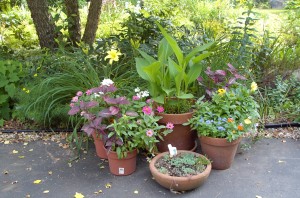 Annuals, particularly those in containers, need additional fertilizer throughout the summer. If you are using a slow-release fertilizer, check the container to see how long it should last – usually three to six month. If you planted in early May with a three month fertilizer, you will need to add more by late July. Some gardeners prefer to apply a diluted liquid fertilizer to containers in order to ensure that the heavy feeders get all they need without overdosing the plants that like a leaner diet.
Annuals, particularly those in containers, need additional fertilizer throughout the summer. If you are using a slow-release fertilizer, check the container to see how long it should last – usually three to six month. If you planted in early May with a three month fertilizer, you will need to add more by late July. Some gardeners prefer to apply a diluted liquid fertilizer to containers in order to ensure that the heavy feeders get all they need without overdosing the plants that like a leaner diet.
If the blooms are slowing down, or the plants are getting scraggly, give them a hard shearing to encourage new growth and new flowers. A shearing just before you leave on vacation should mean you come home to lush new growth – if you have a faithful waterer tending the pots.
Lawns. If you haven’t already, move the blade on your mower up to 3”. The higher grass will shade its own roots, making them less water hungry while shading out new weeds. Consider replacing the grass in hard-to-grow areas (shade for one) with perennials or shrubs that are happier in shade and require less maintenance.
Vegetable Gardens. It’s too early for tomatoes yet, but you should be harvesting green beans, lettuce, peas, beets, chard and onions among others. Plant a new row of lettuce, carrots, beets and chard to extend the season for those. Replant zucchini and green beans when the first batch blooms, keeping the new plants under floating row covers to exclude squash borers and bean beetles. Though row cover looks opaque, they allows over 90% of the sunlight and water into the plants,
Spinosad, a biological control, can be sprayed on plants up to eight days before harvest. Once it dries it affects only those insects that weaken plants by chewing on leaves. It has no effect on pollinators like bees and butterflies.
If you are growing corn, it may need a supplemental feeding before the end of the month. Carefully scratch in a small amount of fertilizer around the roots, then water thoroughly if rain is not expected.
And speaking of water, most trees, shrubs, lawn and perennials do well during dry periods. Vegetables, on the other hand, need regular watering to produce well. Dry spells stunt the plants and reduce the size of the crop they produce.
Houseplants enjoy a summer outside, but if you don’t want to deal with potential insect problems in the fall, keep them on a screened porch. Remember that their small pots need frequent watering if the houseplants are exposed to summer sun and wind.
No doubt we’ll all be praying for rain again soon, but take these first sunny days to clean up the damages wrought by the rains of late June. First, empty all water-filled saucers
under plants. It’s never a good idea to allow a plant to sit in even a small amount of water. Next, empty anything else that may have sat out in the rain and collected water. Mosquitoes take just a week to go from egg to hungry biter so take a walk around your property and clean out unused pots, birdbaths, garden ornaments and anything else that holds even a small amount of water.
Now go to work on the plants that have suffered. I found many buds on certain annuals and perennials blackened and rotted during those wet, dark days. Cut then back to the next leaf set and the plant will soon respond with new flowers. Also, remove and discard waterlogged flowers that have passed their prime before they become a host to fungal or other diseases. And, while cleaning the plants, look for slug and snail damage. They loved this weather. Iron phosphate kills slugs without harming other animals and actually is good for plants whether in the ground or in containers.
If you missed your Father’s Day pruning of plants such as chrysanthemum and asters, do it now and then again a week or so after the 4th of July. This leads to later flowers, but bushier plants with more blooms and a tidier habit. I also cut back some of my balloon flower (Plactycodon) and bee balm (Monarda), dianthus, coneflower (Echinacea), foxglove (Digitalis), Helenium, and veronica. By pinching or trimming back one or two leaf sets of the plants at the front. I get an early bloom from the untouched stems at the rear and a later, bushier bloom from the remainder. It keeps my garden going stronger, longer.
Columbines are one of my favorite early summer plants. They are not long-lived plants, but they are generous with their seed. When the flowers are done, I cut back most, but not all of the seed heads. That way I know that I will have more next year, and if they don’t always appear exactly where I had planned, they move easily.
In the vegetable garden, your early hard work is finally paying off with more than lettuce and radishes. Peas and swiss chard should be ready for your 4th of July dinner, early beets can be pulled along with baby carrots (a good way to thin the bed, if you haven’t already). Your tomatoes, squash and melons will take off with the heat of July. Remember that corn is a heavy feeder and can use a second application of fertilizer after it reaches knee-high. Keep up with the weeds: they deprive your plants of everything they need—sun, space, water and nutrients. And, once the soil dries out, remember that regular watering is vital for a good harvest.
If you are a container gardener, keep in mind that the heavy rains might have washed out the slow release fertilizer (e.g. Osmocote) that you put in when you planted. I am doing a supplemental feeding this week to ensure my containers have the food to make it through the summer. The only exception is any perennials in pots you plan to over-winter. Those perennials get a dose of liquid plant food this month. I don’t feed them after early August so they can slow down and prepare for cold weather. This is good advice whether they stay in the pot or are over-wintered in the ground.
Finish pruning any early spring bloomer now or risk taking off next year’s buds. Also, remove spent flowers so the bush’s strength isn’t wasted setting seeds you don’t want. If you are planting any new trees or shrubs, remember they will need regular, deep watering throughout the summer and fall months to establish good root systems. Consider setting up drip hoses or ‘tree gators’ to free your time while ensuring the water continues to get where it is needed.
Our wet spring with its timely rainstorms helped ensure that our gardens, lawns and trees needed little attention from us. Containers, on the other hand, need us to provide regular watering for two reasons: there is less soil in which to store water and, once the plants in the container have filled out, they may shed most of the water that falls on them. Check them frequently and water until you see the first drops emerge from the bottom of the pot.
If the rains stop or are inadequate, let your wallet be your guide. Water your vegetable garden first; it saves you money at the grocery store. Next, water your trees and shrubs, they are expensive to replace and may take years to recover from a drought. Perennial gardens next. Lawns should be your last priority. They do not die in a drought; rather, they go dormant and green up again as soon as rain and cool temperatures return.
Remove spent flowers. While there are a few varieties out there that promise endless flowers without the trouble of deadheading, for a reliably long bloom period, pick off flowers that have passed their peak. If you allow seed heads to form, the plant receives a signal that its work is over. Snap off large flowers with your fingernails. For small blossoms, or hanging plants gone straggly, shear them back by half with scissors. To prevent plants from looking bare, or like they received a bad haircut, cut off only half the flowers. Wait a week, and cut off the remainder. You’ll be rewarded with a new crop of flowers and tidier plants.
Bugs! It’s hot and humid and the insect hordes are upon us. Simple solutions often keep their numbers down to manageable levels. A strong spray from a hose (in the morning please) will wash off aphids and many others, killing some and leaving others exposed to their enemies.
In the vegetable garden, potato beetles, bean beetles, corn borers and squash borers have made their appearance. Using row covers of spun fabric will prevent the bugs from invading, until covers must be removed for pollination. There are several varieties of Bt, an effective organic solution that targets specific pests. Talk to the staff at a reliable nursery or call the Master Gardener Helpline for more information on which variety to choose to use for your specific pest.
Diseases! Bad bugs are enough of a problem, but what about when everything looks great one day and the next you have fungal disease, mold or mildew? Start with what you can control. Always water early in the day so the leaves dry quickly. Keep a clean garden, removing plant debris, especially if there is any chance it is infected. An organic preventative is a solution of one tablespoon of baking soda in a gallon of water sprayed on the leaves. This makes it difficult for fungal spores or mildew to become established. Finally, there are organic sprays that will control the problem. For information on tomato blight, look for a more complete article in this Leaflet.
Weeds! Keep removing them, they steal, water, nutrients, sunlight and space from your plants. Pulled on a hot day, they will die quickly when exposed to the sun.
